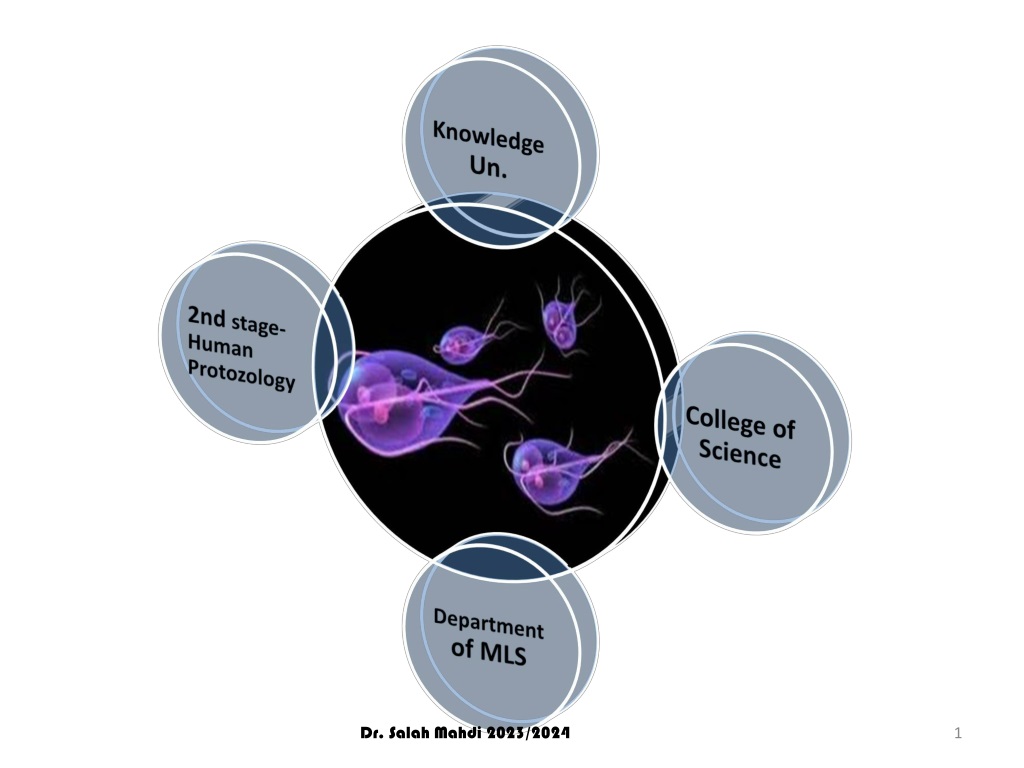

0 likes | 81 Views
Dr. Salah Mahdi introduces the diverse world of protozoa, highlighting their classification, morphology, reproduction, and unique characteristics. Protozoa, being unicellular eukaryotic micro-organisms, exhibit a wide array of organelles and motion styles. The lecture covers the classification of parasites, including Phylum Protozoa, Phylum Platyhelminthes, and Phylum Nemathelminthes. Furthermore, it explores sub-kingdom classifications and details different groups of protozoa based on motion style like Sarcomastigophora, Apicomplexa, and Ciliophora. The lecture delves into specific protozoa species like Giardia lamblia, Trichomonas vaginalis, and more, providing a comprehensive overview of these fascinating microorganisms.

E N D
Lecture-1 Introduction & Classification Dr. Salah Mahdi Dr. Salah Mahdi 2023/2024 2
Dr. Salah M. Saleem/Human Protozology 2ndlevel-2ndterm,2021/2022 • Dear students : • Put your mobile on silent. • Arrive on time. • Copy all notes from the whiteboard. • Write all questions and prepare their perfect answers. 3 Dr. Salah Mahdi 2023/2024
Introduction Introduction and specific terms Classification -1 Classification – 2 Morphplogy –cell structurs Reproduction ( sexual & asexcual) Life cycle (one host & two host) Mid-Term Exam Entamoeba histolystica Endolimax nana & Giardia lambelia Trichomonas vaginalis Plasmodium sp.(Malaria) Trypanosoma sp. (sleeping sickness) Toxoplasma sp. Revision Final Exam Dr. Salah Mahdi 2023/2024 4
Activities 50% • Mid term exam 15%m • Attendee & class activities: 4% • Quizs : 4% • Seminars :2% • =================== • Lab activity (exam 10 + activity 5) = 15% Dr. Salah Mahdi 2023/2024 5
• According to the Greek roots results in defining protozoa as (first=proto) ‘(animals=zoa). Although molecular phylogenetic studies indicate that protozoa are among the earliest branching eukaryotes , such a definition does not provide much descriptive information. Protozoa are not easily defined because they are diverse and are often only distantly related to each other. Due to the extreme diversity of the protozoa the only feature common to all protozoa is that they are unicellular eukaryotic micro-organisms. Dr. Salah Mahdi 2023/2024 6
• Protozoa possess typical eukaryotic organelles and in general .. However, in many protozoan species some of the organelles may be absent, or are morphologically or functionally different from those found in other eukaryotes. In addition, many of the protozoa have organelles that are unique to a particular group of protozoa. • Questions one might ask in regards to defining protozoa include: • What do they look like? • How big are they? • Where do they live? • How do they move about? • How do they reproduce? Dr. Salah Mahdi 2023/2024 7
• Classification of parasites • The parasites which medical human have to deal are divided into three main groups: • 1-Phylum Protozoa- single-celled organism, multiply in human host, Medical Protozoology • 2-Phylum Platyhelminthes and Phylum Nemathelminthes- multicellular worms, do not normally multiply in human host, medical Helminthology. • 3-Phylum Arthropoda – Medical Entomology • While describing animal parasites certain rules of zoological nomenclature are followed and each phylum may be further subdivided as follows: Dr. Salah Mahdi 2023/2024 8
Sub-kingdoom • Phylum • Sub-phylum • Super-class • Class • • • • • • • • Sub-class Order Sub-order Super-Family Family Sub-family Genus species Dr. Salah Mahdi 2023/2024 9
Protozoa according motion style A) Sarcomastigophora 1) Mastigophora (Giardia , Trichomonas). 2) Sarcodina (Antamoeba ,Endolimix) B) Apicomplexa (Sporozoa) 1)Coccidia 2)Haematozoa C) Ciliophora Dr. Salah Mahdi 2023/2024 10
Giardia lamblia Tri. vaginalis E.histolytica E.nana Toxoplasma Plasmodium Dr. Salah Mahdi 2023/2024 12
A-Sarcomastigophora • 1)Mastigophora characteristics: 1-All are flagellates. 2- They have one or more whip like flagella for locomotion at some stage of their life cycle. In some cases, there is the presence of undulating جومتمmembrane (Eg. Trypanosoma). 3-They reproduce asexually by binary fission. *The mastigophora includes (1) the intestinal - Giardia (2) genitourinary flagellates – Trichomonas (3) the blood and tissue flagellates - Trypanosoma, Leishmania, Malaria, Toxoplasma ..etc. Dr. Salah Mahdi 2023/2024 13
Sarcomastigophora cont. https://www.youtube.com/watch?v=7pR7TNzJ_pA • 2)Sarcodina characteristics: 1-They are all typically amoeboid and include Entamoeba, Endolimax, Iodamoeba, Naegleria, Acanthamoeba, etc. Amoebae consist of a shapeless mass of moving cytoplasm which is divided in to granular endoplasm and clear ectoplasm. 2-They move by pushing out the ectoplasm to form pseudopodia (false feet) into which the endoplasm then flow. 3-Amoebae reproduce asexually by simply dividing into two (binary fission) Dr. Salah Mahdi 2023/2024 14
B-Apicomplexa (Sporozoa) • The members of this super-class undergoes complex life cycle with alternating sexual and asexual reproductive phases involving two different hosts. 1-Class Coccidia are intracellular parasites that reproduce asexually by a process called schizogony (merogony) and sexually by sporogony. Coccidia includes Isospora and Toxoplasma . 2-Class Haematozoa includes the malarial parasites- Plasmodium species. Dr. Salah Mahdi 2023/2024 15
C-Ciliophora 1-These are the complex protozoa bearing cilia (short hairs) distributed in rows or patches by which they move. 2-They have two kinds of nuclei (macronucleus and micronucleus) and a large contractile vacuole. • Balantidium coli, a giant intestinal ciliate of humans and pigs, is the only human parasite representative of this group. Dr. Salah Mahdi 2023/2024 16
Reviewing questions • Q1- Why it is not easy to define protozoa? • Q2-What are the groups of protozoa according to the type of movement? • Q3- Give one example for the groups in Q2. • Q4-Write the ranks of classification from the higher level to lower one. • Q5- What are the sites of infection of mastigophoran.? • Q6 –Coccidia are unicellular. ( T .. F) • Q7- Malaria parasite is haematozoan. (T . F) • Q8-Blantedium move by ….. Dr. Salah Mahdi 2023/2024 17